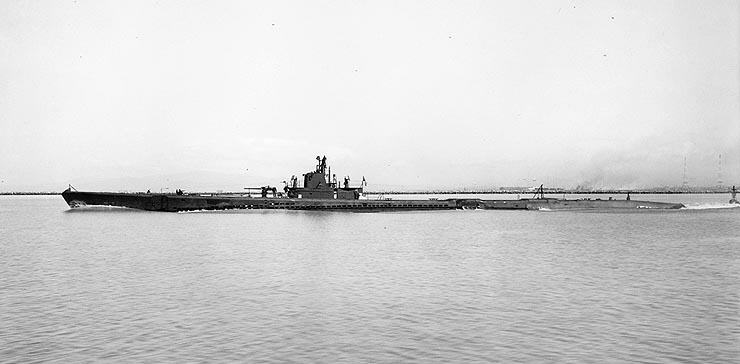

USS Skipjack (SS-184) near Mare Island in 1942
Here is the rest of the story:USS SKIPJACK
June 11, 1942
From: Commanding Officer
To: Supply Officer, Navy Yard, Mare Island, California
Via: Commander Submarines, Southwest PacificSubject: Toilet Paper
Reference: (a) USS HOLLAND (5148) USS SKIPJACK req. 70-42 of 30 July 1941.
(b) SO NYMI Canceled invoice No. 272836Enclosure: (1) Copy of cancelled Invoice (2) Sample of material requested.
1. This vessel submitted a requisition for 150 rolls of toilet paper on July 30, 1941, to USS HOLLAND. The material was ordered by HOLLAND from the Supply Officer, Navy Yard, Mare Island, for delivery to USS SKIPJACK.
2. The Supply Officer, Navy Yard, Mare Island, on November 26, 1941, cancelled Mare Island Invoice No. 272836 with the stamped notation "Cancelled---cannot identify." This cancelled invoice was received by SKIPJACK on June 10, 1942.
3. During the 11 ¾ months elapsing from the time of ordering the toilet paper and the present date, the SKIPJACK personnel, despite their best efforts to await delivery of subject material, have been unable to wait on numerous occasions, and the situation is now quite acute, especially during depth charge attack by the "back-stabbers."
4. Enclosure (2) is a sample of the desired material provided for the information of the Supply Officer, Navy Yard, Mare Island. The Commanding Officer, USS SKIPJACK cannot help but wonder what is being used in Mare Island in place of this unidentifiable material, once well known to this command.
5. SKIPJACK personnel during this period have become accustomed to use of "ersatz," i.e., the vast amount of incoming non-essential paper work, and in so doing feel that the wish of the Bureau of Ships for the reduction of paper work is being complied with, thus effectively killing two birds with one stone.
6. It is believed by this command that the stamped notation "cannot identify" was possible error, and that this is simply a case of shortage of strategic war material, the SKIPJACK probably being low on the priority list.
7. In order to cooperate in our war effort at a small local sacrifice, the SKIPJACK desires no further action be taken until the end of the current war, which has created a situation aptly described as "war is hell."
J.W. Coe
The letter was given to the Yeoman, telling him to type it up. Once typed and upon reflection, the Yeoman went looking for help in the form of the XO. The XO shared it with the OD and they proceeded to the CO's cabin and asked if he really wanted it sent. His reply, "I wrote it, didn't I?"
As a side note, twelve days later, on June 22, 1942 J.W. Coe was awarded the Navy Cross for his actions on the S-39.
The "toilet paper" letter reached Mare Island Supply Depot. A member of that office remembers that all officers in the Supply Department "had to stand at attention for three days because of that letter." By then, the letter had been copied and was spreading throughout the fleet and even to the President's son who was aboard the USS Wasp.
As the boat came in from her next patrol, Jim and crew saw toilet-paper streamers blowing from the lights along the pier and pyramids of toilet paper stacked seven feet high on the dock. Two men were carrying a long dowel with toilet paper rolls on it with yards of paper streaming behind them as a band played coming up after the roll holders. Band members wore toilet paper neckties in place of their Navy neckerchiefs. The wind-section had toilet paper pushed up inside their instruments and when they blew, white streamers unfurled from trumpets and horns.
As was the custom for returning boats to be greeted at the pier with cases of fresh fruit/veggies and ice cream, the Skipjack was first greeted thereafter with her own distinctive tribute-cartons and cartons of toilet paper.
This letter became famous in submarine history books and found its way to the movie ("Operation Petticoat"), and eventually coming to rest (copy) at the Navy Supply School at Pensacola, Florida. There, it still hangs on the wall under a banner that reads, "Don't let this happen to you!" Even John Roosevelt insured his father got a copy of the letter.
The original is at Bowfin Museum in Hawaii:
